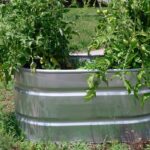Citronella is commonly found in different forms in backyards all over the world since it’s widely known to keep mosquitos away. This oil is a common ingredient in insect repellents, and it can also be found in candle form. But did you know that citronella actually comes from a plant that you can grow yourself?
Citronella plants should be planted in spring, after the last frost. They need plenty of space to grow and should be watered every 2-3 days. Make sure to get citronella grass, rather than citronella geranium, if you plan to use the plant for its bug-repelling oils.
Having your very own citronella plants is a great way to source the oil that keeps mosquitoes at bay. So, let’s look at how to plant and care for a citronella plant at your home.
What Is Citronella?

Citronella is a grass plant that has its roots in tropical areas such as Africa, Asia, the Pacific, and South America. This plant typically grows in bunches together and can reach as high as 2-3 feet tall.
The citronella plant, sometimes known by other names including the mosquito plant geranium and citrosa geranium, gives off a citrusy scent that is said to repel mosquitoes. Keep in mind that while the pesky insect doesn’t like the lemony smell, it’s actually the oil from the citronella grass that has the power to deter them.
How Do You Plant Citronella?
Like other plants, citronella will grow best when they’re planted and taken care of properly, which means getting sufficient sunlight and water. This plant will do well in either the ground or in your favorite planter.
Here are some helpful tips on how to plant citronella for the best results:
- Like tomato plants, citronella does best when planted in the Spring after the threat of frost has gone away.
- When planting your citronella, be sure to space them about 18-24 inches apart to allow them maximum room to grow.
- Plant citronella in an area where it’s in partial sun and make sure your soil can drain well.
- Watering your citronella is only necessary when the top of the soil feels dry to touch, which is usually about every 2-3 days.
- Feed your citronella plant with a water-soluble fertilizer or plant food for better blooms.
- Since citronella responds well to pruning, you should do so regularly.
What Are the Benefits of Planting Citronella?
When it comes to the benefits of planting citronella, most people believe that just having the plant means their backyard will be free of insects such as mosquitos. This, however, is not the main benefit of having the citronella plant in your yard.
The citronella plant gives off a citrusy scent, much like lemongrass, and it makes a great addition to anyone’s garden. This is especially true if you’re outside in the yard quite a bit.
The benefit of planting citronella other than having the fragrant lemony scent flowing through your yard is what it can do to repel mosquitoes. If you extract the oil from the plant and rub it on your skin, it can help to keep those pesky insects away.
Does a Citronella Plant Repel Mosquitos?
While the citronella plant itself does nothing to repel mosquitoes, the oil that can be extracted can be used for this purpose. This means that to get the benefits of keeping you and your family free of mosquito bites, you will need to do more than just grow a citronella plant.
The grass of citronella can be removed from the plant itself and crushed to produce the oil inside. You can then rub the oil on your skin or use it to produce your own candles.
You should keep in mind that if you’re using the citronella plant to repel mosquitoes, then you need to ensure that you have the right plant. This is because only the grass has the oil that is needed to truly keep mosquitoes away.
Citronella Grass vs. Citronella Geranium
If you’re in the market for a citronella plant to add to your garden for both the fragrance it gives off and the purpose of using the oil as an insect repellent, you’ll need to be sure you’re getting the right plant. This is because two different plants are referred to as citronella.
Citronella grass is similar to lemongrass; they have similar fragrances and both produce an essential oil when crushed. Keep in mind that citronella grass is not edible and should not be consumed by any means.
Citronella geranium also gives off the strong citrus scent that is often associated with repelling insects like mosquitoes. However, the citronella geranium doesn’t contain the citronella oil that is used for repelling insects.
What’s the Best Time of Year to Plant Citronella?
As with many other plants, it is best to make sure that the threat of frost has gone away before you decide to plant this fragrant plant. The citronella plant grows much better when the weather is partially sunny.
This means that the best time to plant your citronella is in the spring, once the temperature has begun to rise and frost isn’t going to ruin things.
You can, however, start your citronella in a planter or container indoors any time of the year since it won’t be exposed to the colder elements. This means that if you want to get a head start on growing your citronella, planting it in a container can be a great option.
If you missed the planting season but still want the powerful effects of citronella, consider some outdoor citronella candles (on Amazon) or incense sticks (also on Amazon) to help you keep the bugs away.
Final Thoughts on Growing Citronella

The bottom line is that when it comes to growing a beautiful, healthy citronella plant, there are several things you should keep in mind. You should first and foremost ensure that you’re choosing the right plant to suit your needs.
Once you have the plant home and ready to go, you can either start it in a container or wait until the threat of frost has disappeared. Either way, you will need to make sure your plant has the moisture it needs and the appropriate amount of sunlight.
Additionally, keep in mind that most citronella plants do better when they’re planted in a mix of soil. This means that while they’re fine growing in your native soil, they may do better if you add in some organic matter as well as some plant food regularly.








